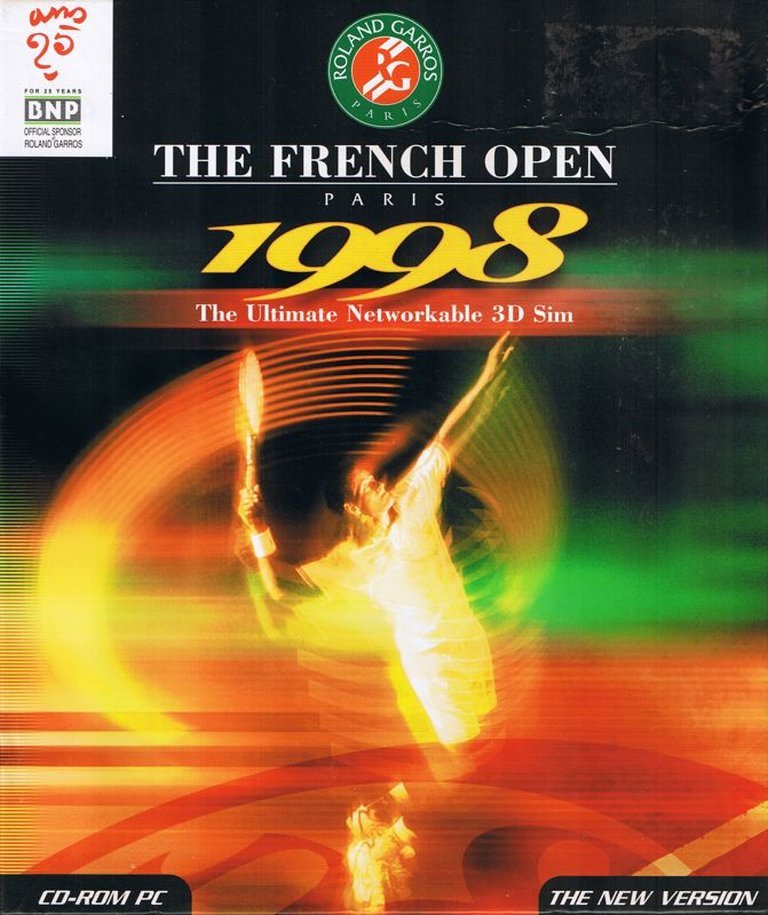- Release Year: 1997
- Platforms: Windows
- Publisher: Microfolie’s Editions
- Developer: Runn Software
- Genre: Sports
- Perspective: 3rd-person
- Game Mode: Online PVP, Single-player
- Gameplay: Court type effects, Tennis simulation
- Setting: Beach, London, New York, Paris, Worldwide
- Average Score: 78/100

Description
The French Open 1998, officially licensed as Roland Garros 1998, is a tennis simulation game where players can compete in customizable matches (singles/doubles, male/female players) across four court types (Hard, Cement, Grass, Synthetic) in venues ranging from Grand Slam courts to exotic beaches. It includes a full season mode where players select 10 tournaments to earn money and points while aiming for the world ranking top spot, with gameplay relying on timing-based shot controls and mastering court-specific mechanics.
Where to Buy The French Open 1998
PC
The French Open 1998: Review
Introduction
The French Open 1998 stands as a commendable effort in the realm of tennis simulations for its time, leveraging the prestige of the Roland Garros tournament to offer players a virtual tennis experience. While it didn’t revolutionize the genre, it provided solid gameplay underpinned by licensed authenticity, delivering a mix of simplicity and strategic depth that polarized critics and players alike.
Development History & Context
Developed by Runn Software and published by Microfolie’s Editions in 1997, The French Open 1998 was a product of its era. The development team harnessed 3Dfx technology to render a graphical experience that was impressive for the time but would soon look dated as hardware evolved. With a development team of 20 people, including movement capture from professional players, the game aimed for authenticity in both movement and gameplay.
The project was anchored by Microfolie’s Project Manager Samuel Gatté and Runn’s Project Manager George Torres. The use of professional tennis players (Thierry Gouret, Frédéric Gomis, Mathiey Cier) for movement captures injected realism into character animations, which was a significant technical achievement for the time. Licensed music and voiceovers (Michel Montana) further elevated the presentation, immersing players in the Roland Garros atmosphere.
Narrative & Thematic Deep Dive
The French Open 1998 lacks a traditional narrative structure. Its “story” is derived from the competitive nature of tennis itself. Players select their avatar (with options for male or female players) andentered into the digital arena to showcase their skills. The full season mode, where players select 10 tournaments and strive for supremacy, provided a framework for progression and accomplishment.
The central theme revolves around the essence of tennis competition—the interplay between technical skill and strategy. The need to adapt to different court types (Hard, Cement, Grass, Synthetic), each affecting ball bounce and speed, adds a layer of complexity that mirrors real-world tennis dynamics. This theme of adaptation underscores the gameplay, challenging players to master various court conditions, whether playing on the hallowed clay courts of Roland Garros or exotic venues like the paradisiacal beach courts.
Gameplay Mechanics & Systems
The gameplay of The French Open 1998 is unapologetically straightforward. Akin to classic tennis games, players use two buttons to control shot direction—slice and topspin. The timing between pressing the button and hitting the ball dictates the shot’s trajectory. This simple control scheme makes the game accessible but requires precision timing, offering a satisfying skill curve.
The physics engine is a highlight. Each court type behaves differently, requiring players to adjust their playstyle. The hard courts provide rapid ball movement, while the clay courts at Roland Garros slow the ball, favoring patience and controlling the baseline. Players must master both serving and volleying strategies, adding depth to the gameplay.
Multiplayer options, including internet play for up to 4 players, were ahead of their time. However, technical constraints of the era might have limited the online experience. The single-player season mode introduces money and points systems that affect placement in the rankings, adding a layer of progression and goal-oriented play.
Challenges include the AI players’ difficulty, which might be too forgiving for pros or too challenging for beginners. Additionally, the absence of more detailed player customization—like stats or equipment—might leave some players wanting more depth.
World-Building, Art & Sound
The game’s world-building is centered around recreating the Roland Garros experience. The introduction videos and in-game graphics, while modest by modern standards, were serviceable for 1997. The courts are accurately modeled, with distinct visual themes for different venues. On-court crowds, though static, contribute to the atmosphere. The CG introduction by Locamotion likely wowed players with its cutting-edge computer graphics of the time.
Sound design employs the voice of Michel Montana, a well-known French sports personality, enhancing immersion. Crowd noises, ball impacts, and commentator voiceovers add auditory layers that make matches come alive.
The music by Hal Bop, while minimal, effectively punctuates key moments. However, the overall soundscape might lack the dynamism of more recent titles.
Reception & Legacy
Upon release, The French Open 1998 received mixed reviews. PC Jeux awarded an 86%, lauding the graphics and gameplay. PC Zone gave a more conservative 70%, appreciating the straightforward action but critiquing graphical limitations and lack of frills. Player reviews were average, indicating divided opinions.
The game’s legacy is undeniable as part of the Roland Garros licensees and a precursor to future tennis simulation titles. Its influence can be seen in games focusing on real-world sports licenses and physics-based gameplay. Although overshadowed by later entries like Virtua Tennis and Grand Slam Tennis, The French Open 1998 earns a respected place in the history of sports gaming.
Conclusion
The French Open 1998 stands as a solid entry in the tennis simulation genre for its time. Its blend of accessible controls, realistic physics, and approvable presentation offered a pleasurable virtual tennis experience. While it didn’t break new ground, it effectively harnessed 1997’s hardware capabilities and remains a fondly remembered title among niche sports gaming enthusiasts.